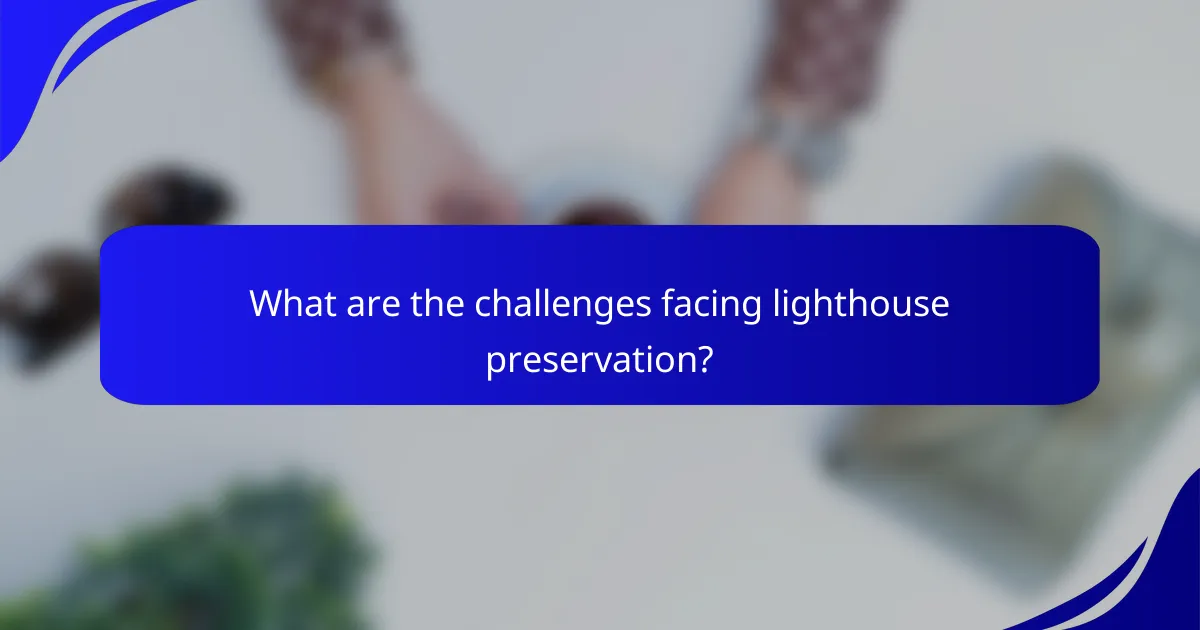Lighthouses serve as vital attractions that enhance tourism in coastal regions, drawing visitors to explore their historical and cultural significance. These iconic structures not only symbolize maritime safety but also stimulate local economies by creating jobs and promoting heritage tourism. Their unique charm and picturesque settings make them essential landmarks that reflect the rich maritime history of the areas they inhabit.

How do lighthouses impact tourism in Australia?
Lighthouses significantly enhance tourism in Australia by attracting visitors to coastal areas and promoting local heritage. These iconic structures not only serve as picturesque landmarks but also provide unique experiences that draw tourists to explore the surrounding regions.
Attraction of coastal visitors
Lighthouses are often situated in stunning coastal locations, making them popular spots for sightseeing and photography. Tourists are drawn to their historical architecture and the scenic views they offer, which can lead to increased foot traffic in nearby towns.
Many lighthouses have viewing platforms or accessible grounds, allowing visitors to enjoy panoramic ocean vistas. This natural beauty, combined with the allure of maritime history, makes lighthouses a must-see for many travelers.
Boost to local businesses
The influx of tourists visiting lighthouses can provide a substantial boost to local economies. Restaurants, cafes, and shops in proximity to these attractions often see increased patronage, especially during peak tourism seasons.
Local businesses can capitalize on lighthouse tourism by offering themed merchandise, guided tours, and special events. This not only enhances the visitor experience but also fosters community growth and sustainability.
Historical tours and events
Many lighthouses in Australia host historical tours that educate visitors about their significance and maritime heritage. These tours often include storytelling, artifacts, and sometimes even access to the lighthouse’s interior, enriching the tourist experience.
Additionally, various events such as lighthouse festivals, open days, and educational workshops are organized around these sites. Such activities not only attract tourists but also promote community engagement and appreciation for local history.

What is the economic significance of lighthouses in local communities?
Lighthouses play a vital role in boosting the economic significance of local communities by attracting tourists and creating jobs. Their historical and cultural value draws visitors, which in turn stimulates local economies through various sectors.
Job creation in tourism sectors
The presence of lighthouses often leads to job creation in tourism-related sectors such as hospitality, guiding services, and retail. Local businesses, including hotels and restaurants, benefit from increased visitor traffic, leading to more employment opportunities in these areas.
For example, a popular lighthouse can create dozens of jobs, from tour guides to staff in nearby cafes and shops. Seasonal employment may also rise during peak tourist months, providing additional income for local residents.
Revenue generation from lighthouse tours
Lighthouse tours generate significant revenue for local communities, often charging entrance fees or offering guided experiences. These tours not only provide educational insights into maritime history but also contribute directly to the local economy.
Communities can expect varying revenue levels based on visitor numbers, with successful lighthouses potentially earning thousands of dollars monthly. This income can be reinvested into community projects or maintenance of the lighthouse itself.
Support for local artisans and vendors
Lighthouses can support local artisans and vendors by providing a platform for selling crafts, souvenirs, and local products. Many lighthouses feature gift shops or markets that showcase the work of local artists, enhancing the visitor experience while promoting regional culture.
By collaborating with local artisans, lighthouse operators can create unique offerings that attract tourists, such as handmade goods or locally sourced foods. This symbiotic relationship enriches the community and fosters a sense of pride in local craftsmanship.

What historical significance do lighthouses hold in Australia?
Lighthouses in Australia are vital historical landmarks that symbolize maritime safety and navigation. They reflect the nation’s maritime heritage, showcasing the evolution of navigation technology and serving as cultural icons for coastal communities.
Maritime navigation advancements
Lighthouses have played a crucial role in the advancements of maritime navigation by providing essential guidance to sailors. The introduction of light signals and foghorns improved safety by helping vessels avoid treacherous coastlines and reefs.
In Australia, many lighthouses were built in the 19th century, incorporating innovative technologies of their time, such as Fresnel lenses, which significantly enhanced visibility. These advancements not only facilitated safer passage for ships but also contributed to the growth of trade and commerce along the coast.
Cultural heritage sites
Many Australian lighthouses are recognized as cultural heritage sites, reflecting the architectural styles and engineering feats of their respective eras. They often attract tourists and serve as focal points for local history and storytelling.
For instance, the Cape Byron Lighthouse, built in the late 19th century, is not only an operational lighthouse but also a popular tourist destination, offering stunning views and insights into maritime history. Preservation efforts ensure that these sites remain part of the cultural landscape.
Preservation of local history
Lighthouses are integral to preserving local history, often serving as museums or visitor centers that educate the public about maritime heritage. They house artifacts, photographs, and documents that tell the stories of the communities they serve.
Local initiatives frequently involve community members in restoration projects, fostering a sense of pride and ownership. This engagement helps ensure that the historical significance of lighthouses is maintained for future generations, reinforcing their role as symbols of safety and guidance along Australia’s coastlines.

How can communities leverage lighthouses for economic growth?
Communities can leverage lighthouses for economic growth by promoting them as tourist attractions and integrating them into local events and partnerships. By enhancing accessibility and creating engaging experiences around these historical structures, towns can boost visitor numbers and stimulate local economies.
Developing lighthouse festivals
Lighthouse festivals can draw significant crowds and create a festive atmosphere that celebrates local heritage. These events may include guided tours, historical reenactments, art displays, and local food vendors. Communities should consider scheduling festivals during peak tourist seasons to maximize attendance and revenue.
Incorporating activities like lighthouse climbs or photography contests can further engage visitors. Collaborating with local artisans and businesses can enhance the festival experience while supporting the local economy.
Creating partnerships with tourism boards
Forming partnerships with local tourism boards can amplify marketing efforts and attract more visitors to lighthouses. These collaborations can include joint advertising campaigns, shared resources for event planning, and cross-promotion of attractions. Communities should ensure that their lighthouses are featured prominently in regional tourism materials.
Additionally, working with tourism boards can help secure funding for maintenance and improvements, ensuring that lighthouses remain safe and appealing to visitors. Regular meetings with tourism officials can help align goals and strategies for maximizing economic impact.
Enhancing lighthouse accessibility
Improving accessibility to lighthouses is crucial for attracting a broader audience. This may involve upgrading pathways, providing signage, and ensuring facilities are wheelchair-friendly. Communities should assess current access points and identify areas for improvement to accommodate all visitors.
Offering guided tours that cater to different age groups and abilities can enhance the visitor experience. Consideration of local transportation options, such as shuttle services or bike rentals, can also make lighthouses more accessible to tourists without personal vehicles.

What are the challenges facing lighthouse preservation?
Lighthouse preservation faces several challenges, including funding shortages, environmental threats, and the need to balance tourism with conservation efforts. These issues can hinder the maintenance and protection of these historical structures, which are vital to both heritage and local economies.
Funding for maintenance
Securing adequate funding for lighthouse maintenance is a significant challenge. Many lighthouses are maintained by local governments or non-profit organizations that often operate on limited budgets. Grants, donations, and public funding can help, but they are frequently insufficient to cover the extensive costs associated with repairs and upkeep.
To improve funding, lighthouse preservation groups can engage in fundraising campaigns, seek partnerships with local businesses, or apply for heritage grants. Establishing a clear budget and demonstrating the economic benefits of tourism can also attract more financial support.
Environmental impacts on coastal structures
Coastal lighthouses are increasingly threatened by environmental factors such as rising sea levels, erosion, and severe weather events. These natural challenges can undermine the structural integrity of lighthouses, making regular assessments and repairs essential.
Preservation efforts must consider the local environment and implement adaptive strategies. For instance, reinforcing foundations, using weather-resistant materials, and creating buffer zones can help mitigate damage from environmental impacts.
Balancing tourism and conservation
Tourism can provide essential revenue for lighthouse preservation, but it can also lead to wear and tear on these structures. Striking a balance between attracting visitors and protecting the lighthouse’s integrity is crucial for long-term sustainability.
To achieve this balance, lighthouse operators can implement visitor limits, develop educational programs, and create designated viewing areas. These strategies can enhance the visitor experience while ensuring that conservation efforts remain a priority.

How do lighthouses compare to other tourist attractions?
Lighthouses offer a distinctive blend of history, scenic views, and maritime culture that sets them apart from more conventional tourist attractions. While many sites focus on entertainment or shopping, lighthouses provide unique experiences that can enhance local tourism and economy.
Unique experiences vs. traditional attractions
Lighthouses often feature breathtaking coastal views and rich historical narratives, making them appealing to visitors seeking both adventure and education. Unlike traditional attractions such as amusement parks or shopping malls, lighthouses allow for exploration of maritime heritage, often accompanied by guided tours or interactive exhibits.
Many lighthouses are situated in picturesque locations, providing opportunities for photography, hiking, and picnicking. This natural setting can attract visitors looking for a more tranquil experience, contrasting with the hustle and bustle of urban attractions.
Visitor demographics and preferences
Visitors to lighthouses tend to be diverse, including families, history enthusiasts, and nature lovers. Many are drawn by the unique stories of each lighthouse, often seeking educational experiences that traditional attractions may not offer.
Preferences vary, with some visitors favoring guided tours that delve into the history and architecture of the lighthouse, while others may prefer self-guided exploration. Understanding these demographics can help local businesses tailor their offerings to enhance the overall visitor experience and boost the local economy.
